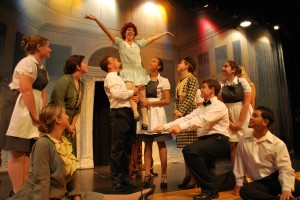
This article’s criticism pertains to the opening night of Annie. Reviews of subsequent showings will be posted briefly.
It is almost inevitable that any viewer of Annie, which opened Thursday, April 12, will leave the theater feeling optimistic for the future. The harmonious orchestra, flashy lighting and classic tunes create the vision that the suffering Depression-era world may have only been a small dent in human history that fails to reflect a brighter light shining through. The show has a casual, exuberant, feel-good quality to it that, while it may not fully invigorate every viewer but will surely spread a smile on the grimmest of faces.
For those unfamiliar with this classic production, the show follows the story of Annie (senior Mallory Steffes, as well as junior Savanna Ritchie and senior Cassidy Fishman on later dates), an 11-year-old orphan living in New York City during the Great Depression. Annie is one of several dozen girls living in an orphanage run by the gruesome Mrs. Hannigan (sophomore Taylor Fishman, as well as drama director Lindsay Painter on later dates) until she is selected to live with billionaire Oliver Warbucks (senior Daniel Davis, as well as senior Louis Lage on later dates) for the holidays. Warbucks begins to feel affectionate towards Annie, but they are soon threatened by Mrs. Hannigan and her accomplices, who develop a scheme to acquire some fast cash and eliminate Annie. Nevertheless, Annie’s bright optimism creates a positive aura surrounding the story even in the dark moments. 
Leading this cheery atmosphere on the first night was Steffes, who played her role with blatant talent. Steffes’ vocal strength and skill in several dance numbers moved the show along, but it almost seemed like she was not interested in the role she was playing. Her theatrical skill was enough to make the show successful, though.
Complementing Steffes’ musical flair was a cast loaded with talented performers. Fishman’s exceptionally comical depiction of an alcoholic matron was particularly well done. Fishman’s role culminated in the final scenes, when the range of her theatrical ability was fully exposed. As a whole, though, I was surprised by how many Steinbrenner students possessed such raw talent. It was easy to see why the drama department has consistently been awarded.
Linking this talent together was the choreography, crafted by junior Sydney Blackburn and Kelsie McDonell, which possessed a creative complex rarely found on the high school theatre stage. This highlight was undermined by the lack of synchronization in a number of the musical numbers.
The biggest flaw in the production (though it’s excusable considering this was opening night) was the sound and lighting in the first act. The flickering of the microphones on and off was an unfortunate distraction and the seemingly confused lights darted across the stage before hitting the performers. However, these faults were corrected in the second act, which made a noticeable difference.
However, the true unsung hero of this production was the orchestra. The music gave the show a dimension that is hard to capture outside of the Broadway pit. A relive orchestra, sitting right there in front of the audience, gave the show an authentic feel along with wonderful sound.
As the finale came to a close and the performers took their bows, I could not help but feel a sense of excitement that any seasoned theatre attendee can recognize. The show had a few murky spots, but the sheer talent in the drama department was undeniable, regardless of any flaws in the production or the play itself. Score: 7.5/10.
Natalie Barman / Opinion Editor
